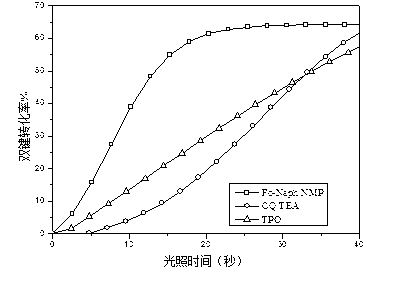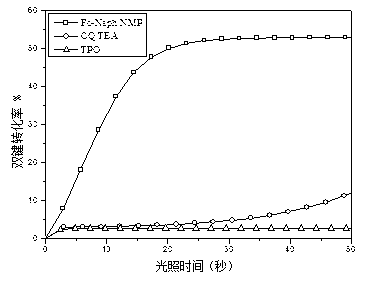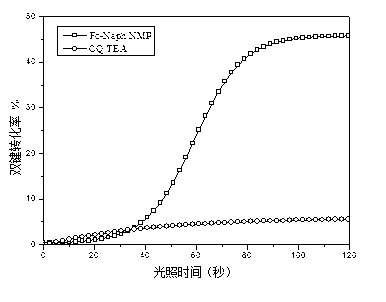Bicomponent free radical type visible light initiation system and application thereof
A technique of initiating system and free radical, which is applied in applications, optical record carriers, household appliances, etc., can solve the disadvantages of improving the compatibility of photoinitiating system with free radical monomers and prepolymers, and the weak light absorption capacity of camphorquinone , affect the performance of curing materials and other issues, to achieve the effect of simple composition, good photoinitiation performance, and good curing degree
- Summary
- Abstract
- Description
- Claims
- Application Information
AI Technical Summary
Problems solved by technology
Method used
Image
Examples
Embodiment 1
[0031] Weigh 0.158g [cyclopentadiene-iron-naphthalene] hexafluorophosphate (Ⅲ, Fc-Naph, 0.4mmol) into a brown bottle, then add 2mL N-methylpyrrolidone (NMP, 2mmol), stir well Completely dissolve [cyclopentadiene-iron-naphthalene] hexafluorophosphate, then add 10 g of free radical monomer tripropylene glycol diacrylate (TPGDA, Jiangsu Sanmu Group), stir well and store in the dark. The prepared sample is evenly coated in a rubber ring (fixed diameter) between two pieces of glass, irradiated by a 50W halogen lamp (Suzhou Huiyi Industrial Materials Co., Ltd.) at room temperature, and each sample is repeated by near-infrared scanning three times. It should be noted that the same sample point was irradiated under the halogen lamp once in a while and immediately carried out an infrared scan. In addition, the illuminance of the halogen lamp should be adjusted to 1.0mW / cm before use. 2 (Illuminance meter from Photoelectric Instrument Factory, Beijing Normal University). Near-infrare...
Embodiment 2
[0036] Weigh 0.158g [cyclopentadiene-iron-naphthalene] hexafluorophosphate (Ⅲ, Fc-Naph, 0.4mmol) into a brown bottle, then add 2mL N-methylpyrrolidone (NMP, 2mmol), stir well Completely dissolve [cyclopentadiene-iron-naphthalene] hexafluorophosphate, then add 10 g of free radical monomer tripropylene glycol diacrylate (TPGDA, Jiangsu Sanmu Group), stir well and store in the dark. Using a method similar to that in Example 1, irradiate the prepared sample through a 50W halogen lamp and place a broadband filter λ≥460nm (Guangzhou Languang Electronic Technology Co., Ltd.) at room temperature, and adjust the illumination to 2.0mW / cm 2 . The conversion rate of double bond polymerization of TPGDA in photocuring system was detected by near-infrared spectroscopy. See attached for conversion rate data figure 2 . It can be seen from the figure that after using a broadband filter λ≥460nm, the double bond conversion rate and photocuring speed of TPGDA in the Fc-Naph / NMP system are al...
Embodiment 3
[0040] Weigh 0.158g [cyclopentadiene-iron-naphthalene] hexafluorophosphate (Ⅲ, Fc-Naph, 0.4mmol) into a brown bottle, then add 2mL N-methylpyrrolidone (NMP, 2mmol), stir well Completely dissolve [cyclopentadiene-iron-naphthalene] hexafluorophosphate, then add 10 g of free radical monomer tripropylene glycol diacrylate (TPGDA, Jiangsu Sanmu Group), stir well and store in the dark. Using a method similar to that in Example 1, put the prepared sample through a 50W halogen lamp and place an interference filter λ=540nm (Guangzhou Languang Electronic Technology Co., Ltd.) and then irradiate at room temperature. Before use, adjust the illumination to 5.0mW / cm 2 . The conversion rate of double bond polymerization of TPGDA in the photocuring system was detected by near-infrared spectroscopy. See attached for conversion rate data image 3 . It can be seen from the figure that after using the broadband filter λ=540nm, the double bond conversion rate and photocuring speed of TPGDA in...
PUM
 Login to View More
Login to View More Abstract
Description
Claims
Application Information
 Login to View More
Login to View More - R&D
- Intellectual Property
- Life Sciences
- Materials
- Tech Scout
- Unparalleled Data Quality
- Higher Quality Content
- 60% Fewer Hallucinations
Browse by: Latest US Patents, China's latest patents, Technical Efficacy Thesaurus, Application Domain, Technology Topic, Popular Technical Reports.
© 2025 PatSnap. All rights reserved.Legal|Privacy policy|Modern Slavery Act Transparency Statement|Sitemap|About US| Contact US: help@patsnap.com



